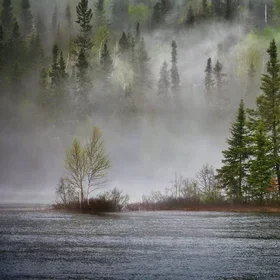By Steven Cohen, Ph.D., Director of the M.S. in Sustainability Management program, School of Professional Studies
It doesn’t take a doctorate in political science to understand the differences on environmental policy held by today’s national Democratic and Republican parties. It wasn’t always this way. Republican Teddy Roosevelt was a founder of the movement to conserve the American wilderness. According to the website of the National Park Service:
“The conservation legacy of Theodore Roosevelt is found in the 230 million acres of public lands he helped establish during his presidency. Much of that land—150 million acres—was set aside as national forests. Roosevelt created the present-day USFS [United States Forest Service] in 1905, an organization within the Department of Agriculture. The idea was to conserve forests for continued use. An adamant proponent of utilizing the country’s resources, Roosevelt wanted to ensure the sustainability of those resources. Roosevelt was also the first president to create a Federal Bird Reserve, and he would establish 51 of these during his administration. These reserves would later become today’s national wildlife refuges, managed by the United States Fish and Wildlife Service (USFWS). Today there is a national wildlife refuge in every state, and North Dakota boasts the most refuges of any state in the country. During Roosevelt’s administration, the National Park System grew substantially. When the National Park Service was created in 1916—seven years after Roosevelt left office—there were 35 sites to be managed by the new organization. Roosevelt helped create 23 of those.”
It wasn’t just Teddy. The president who established the Environmental Protection Agency in 1970 was Republican Richard Nixon. When he decided to veto the 1972 Federal Water Pollution Control Act, a bipartisan supermajority in Congress overrode his veto. Environmental protection was once a bipartisan issue, since, as I always say, “everyone likes to breathe … it’s something that’s easy to get used to.”
But times have changed, and we live in a polarized, ideologically oriented country. This did not start with Donald Trump’s presidency, but with the presidency of Ronald Reagan. Reagan’s initial environmental appointments in EPA and the Department of Interior were right-wing ideologues. Fortunately for the planet, these leaders made mistakes, and before facing reelection in 1984, Reagan fired Anne Gorsuch at EPA and James Watt at Interior and returned EPA to the moderate environmentalism of its origins. Ronnie brought back William Ruckelshaus, EPA’s first visionary administrator. Despite this more moderate course, America’s path-breaking initiatives in environmental protection never really returned. Bill Clinton and Barack Obama could not get environmental legislation through Congress. Climate policy never got anywhere despite Obama’s determined efforts. For those of us who worked on national environmental policy in the 1970s, the action by necessity moved long ago to the state, municipal, and community level. More recently some of us have focused on the integration of sustainability management in the private sector. All of that makes the federal government less central than it was a half century ago. This is not an argument against the incredibly useful federal environmental funding that the Biden team included in the Inflation Reduction Act and the bipartisan Infrastructure Act; these federal actions will accelerate the transition to a renewable resource-based economy. It’s simply to acknowledge that we’ve learned not to expect or depend on the federal government. This has especially become true as the Supreme Court continues to limit the national government’s regulatory authority.
Our national government seems to be on an environmental merry-go-round. The Trump White House discarded about 100 environmental regulations, and then the Biden White House restored them. Scientists in the Environmental Protection Agency were attacked and ignored during Trump’s White House years. Many eventually gave up and abandoned the agency. Biden’s EPA administrator Michael Regan then spent the past three and a half years rebuilding the scientific capacity that the Trump team destroyed. The United States needs a federal environmental agency, and its destruction would be a disaster. But fortunately, there are many other American institutions and governments that help protect the environment, and another four years of federal neglect would be deeply unfortunate but not fatal. Today, EPA has a staff of about 17,000—an increase of 1,000 over last year and of 3,000 over the 14,000 at the end of the Trump presidency. But even at its peak, EPA is understaffed and underfunded.
Fortunately, the federal government is not the only game in town. In fact, state and local spending on drinking-water safety, sewage treatment, solid-waste management, and air pollution mitigation dwarfs federal spending. As the Trump era ended in 2021, Lynda Lee of the Census Bureau observed:
“Environmentalists have long been pushing the government, consumers and corporations to protect our planet, promoting everything from tougher environmental standards to paperless communications and environmentally friendly products like reusable shopping sacks. Government is stepping up … state and local governments are spending more on preserving natural resources. According to the U.S. Census Bureau’s Annual Survey of State and Local Government Finances, public spending to protect the nation’s natural resources jumped from $27.7 billion in 2014 to $32.3 billion in 2018. … According to the Census Bureau’s Annual Survey of Public Employment & Payroll, in March 2020 there were 189,668 employees in the natural resources functions of state and local governments: 83% (156,768) were full-time and 17% (32,900) part-time. While expenditures rose, a five-year comparison (from 2016 to 2020) showed a 5.7% decline in part-time employment and a 0.3% dip in full-time employment.”
The advantage of federalism in the United States is that many critical programs that protect the environment are built on revenues generated at the state and local levels. Americans pay water bills, waste management bills, and other taxes that fund critical environmental services. In 2018, state and local governments spent $58.8 billion on sewage treatment, $26 billion on solid-waste management and (as noted above) $32.3 billion on natural-resource preservation and management.
In addition to the environmental protection managed by state and local governments, we also see a great deal of environmental work in the private and nonprofit sectors. More and more corporations are looking to reduce costs and environmental impacts by increasing energy efficiency and expanding their use of renewable energy. These companies are also examining their use of toxins and their waste management practices. Many are redesigning products for remanufacture and are changing the packaging they use in shipping.
Nonprofit institutions such as universities and hospitals are establishing positions and offices to promote environmental sustainability throughout their organizations. This is a reflection of changes in management practice and culture and not a response to government regulation. This tendency is immune to political ideology and has increased in the face of the ongoing dysfunction in Washington, D.C.
Additionally, it is important to remember that for global issues such as climate, biodiversity, and ocean pollution, America is only one of many sovereign nations involved. The United States federal government might end efforts to reduce greenhouse gas pollution, but large American states like California and New York, and nations in Europe and Asia, will continue their efforts to reduce their use of fossil fuels.
While we have learned to protect the environment without the federal government, we do need national rules and standards. This requires cutting-edge scientific analysis to understand the causes and effects of environmental degradation. It also requires an efficient and thoughtful regulatory process that carefully and pragmatically weighs costs and benefits and works with business to reduce the negative impacts of pollution from old and new technologies. Doing without national policy makes it difficult to manage pollution that crosses jurisdictions and leaves poorer states vulnerable because of inadequate state and local environmental protection. The sewage pollution that has backed up into people’s homes in Jackson, Mississippi, is a case study of inadequate state and local environmental capacity and the critical role of federal regulation and organizational capacity.
Many environmentalists are fearful of the impact of a second Trump administration on environmental protection. Recently in The New York Times, Coral Davenport, Christopher Flavelle, and Lisa Friedman observed:
“On the campaign trail, Donald J. Trump has repeatedly said that he wants “the cleanest air and the cleanest water.” But as president, Mr. Trump dissolved the nation’s protections for those basic elements, as well as public lands, endangered species and the climate. He sought to silence government scientists and gutted the federal agencies charged with safeguarding the environment. And he gave control of those agencies to lobbyists from the regulated industries. … If Mr. Trump wins next week’s election, he … and his allies have mapped out a plan to dismantle the legal and scientific foundations of the federal government’s authority to regulate the environment, particularly on climate change.”
If a second Trump administration is elected tomorrow, it is obvious that environmental regulation and organizational capacity will be impaired. Even a Harris administration will likely face ideological hostility to climate and biodiversity policy in Congress. Anti-environmental policy is typically disguised as anti-big-government regulation, but that strategy has limits. If your home is destroyed by climate-change-induced floods or fire or your children are exposed to toxins that make them ill, anti-regulatory ideology is quickly discarded in the face of experiential reality. Moreover, as I believe I’ve demonstrated, the number of non-federal players in environmental protection is massive and growing. For more than four decades, we have managed to overcome dysfunctional national environmental policy. It’s not fun, but it’s not like we haven’t watched this movie before.
About the Program
The Columbia University M.S. in Sustainability Management program offered by the School of Professional Studies in partnership with the Climate School provides students cutting-edge policy and management tools they can use to help public and private organizations and governments address environmental impacts and risks, pollution control, and remediation to achieve sustainability. The program is customized for working professionals and is offered as both a full- and part-time course of study.



